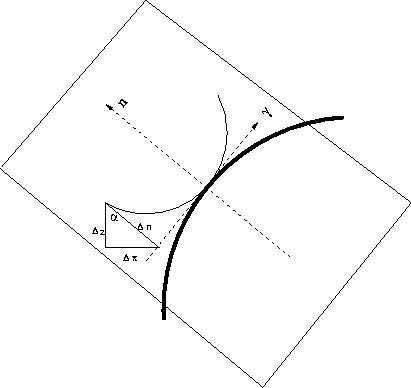




Next: Synthetic data example
Up: Shan and Biondi: Residual
Previous: Angle-domain CIGs
Conventional residual moveout is usually performed in the space domain. It assumes that the reflectors are
flat, and thus image points only need to move vertically to flatten the ADCIGs.
However, in dip-dependent residual moveout, the image points are moved
along the direction normal to the reflector to flatten the ADCIGs.
It is difficult to calculate an accurate dip map for an image in the space domain,
but the dip map can be obtained easily in the Fourier domain by the following relation:
|  |
(3) |
where  is the dip angle,
and kx and kz are the wave numbers of x and z direction, respectively.
In the local versions of equation (1) and (2), the shift along the
direction normal to the reflectors depends only on the dip angle
is the dip angle,
and kx and kz are the wave numbers of x and z direction, respectively.
In the local versions of equation (1) and (2), the shift along the
direction normal to the reflectors depends only on the dip angle  and the opening angle
and the opening angle  .
In the Fourier domain, the dip angle
.
In the Fourier domain, the dip angle  is calculated by equation (3), and the opening
angle
is calculated by equation (3), and the opening
angle  by
by
|  |
(4) |
where kh is the wave number of offset h Sava and Fomel (2003). Let  be the shift along the direction
normal to the reflectors.
From the geometric relation, the shift along the normal direction is equivalent to a horizontal shift
be the shift along the direction
normal to the reflectors.
From the geometric relation, the shift along the normal direction is equivalent to a horizontal shift
 followed by a vertical shift
followed by a vertical shift  .
Figure
.
Figure ![[*]](http://sepwww.stanford.edu/latex2html/cross_ref_motif.gif) shows, for an ADCIG at a reflection point with a dip angle of
shows, for an ADCIG at a reflection point with a dip angle of  ,
the relation between normal direction shift
,
the relation between normal direction shift  , horizontal shift
, horizontal shift  and vertical
shift
and vertical
shift  .
geometry
.
geometry
Figure 2 Geometric relation between the shift in normal direction  , the horizontal
shift
, the horizontal
shift  and the vertical shift
and the vertical shift  .
.

A shift in the space domain is equivalent to a phase shift in the Fourier domain.
Let I(x,z,h) be
the image cube obtained by migration, and I(kx,kz,kh) is its Fourier transformation.
Then in the space domain, the shift  along the direction normal to the reflector is equivalent to
a phaseshift of kx followed by a phaseshift of kz:
along the direction normal to the reflector is equivalent to
a phaseshift of kx followed by a phaseshift of kz:
|  |
(5) |
in the Fourier domain.





Next: Synthetic data example
Up: Shan and Biondi: Residual
Previous: Angle-domain CIGs
Stanford Exploration Project
10/14/2003
![[*]](http://sepwww.stanford.edu/latex2html/cross_ref_motif.gif) shows, for an ADCIG at a reflection point with a dip angle of
shows, for an ADCIG at a reflection point with a dip angle of 
![]() along the direction normal to the reflector is equivalent to
a phaseshift of kx followed by a phaseshift of kz:
along the direction normal to the reflector is equivalent to
a phaseshift of kx followed by a phaseshift of kz: